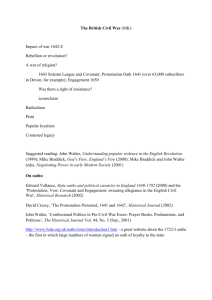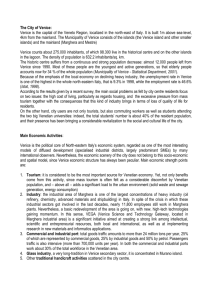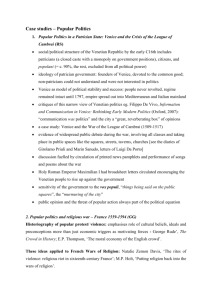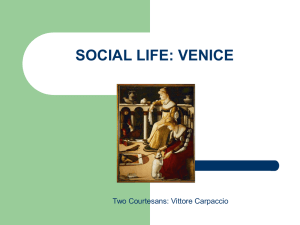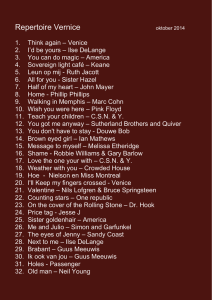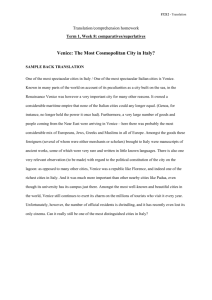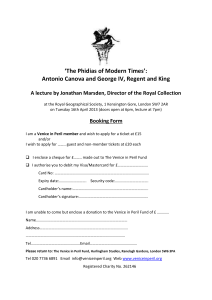The Venetian Money System
advertisement
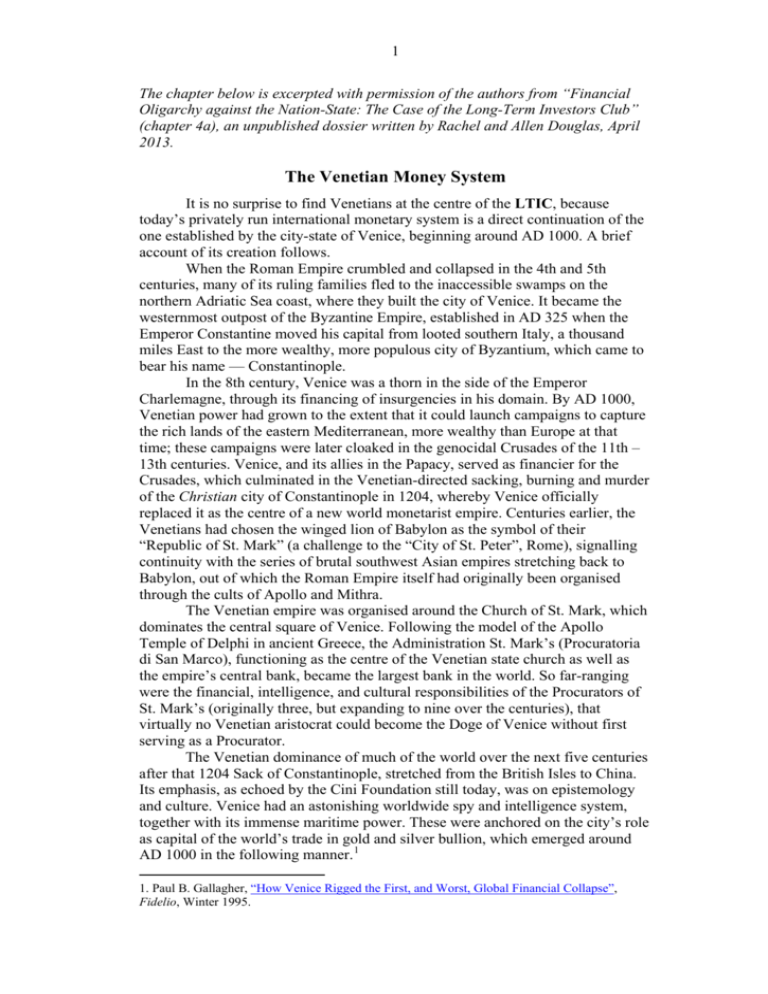
1 The chapter below is excerpted with permission of the authors from “Financial Oligarchy against the Nation-State: The Case of the Long-Term Investors Club” (chapter 4a), an unpublished dossier written by Rachel and Allen Douglas, April 2013. The Venetian Money System It is no surprise to find Venetians at the centre of the LTIC, because today’s privately run international monetary system is a direct continuation of the one established by the city-state of Venice, beginning around AD 1000. A brief account of its creation follows. When the Roman Empire crumbled and collapsed in the 4th and 5th centuries, many of its ruling families fled to the inaccessible swamps on the northern Adriatic Sea coast, where they built the city of Venice. It became the westernmost outpost of the Byzantine Empire, established in AD 325 when the Emperor Constantine moved his capital from looted southern Italy, a thousand miles East to the more wealthy, more populous city of Byzantium, which came to bear his name — Constantinople. In the 8th century, Venice was a thorn in the side of the Emperor Charlemagne, through its financing of insurgencies in his domain. By AD 1000, Venetian power had grown to the extent that it could launch campaigns to capture the rich lands of the eastern Mediterranean, more wealthy than Europe at that time; these campaigns were later cloaked in the genocidal Crusades of the 11th – 13th centuries. Venice, and its allies in the Papacy, served as financier for the Crusades, which culminated in the Venetian-directed sacking, burning and murder of the Christian city of Constantinople in 1204, whereby Venice officially replaced it as the centre of a new world monetarist empire. Centuries earlier, the Venetians had chosen the winged lion of Babylon as the symbol of their “Republic of St. Mark” (a challenge to the “City of St. Peter”, Rome), signalling continuity with the series of brutal southwest Asian empires stretching back to Babylon, out of which the Roman Empire itself had originally been organised through the cults of Apollo and Mithra. The Venetian empire was organised around the Church of St. Mark, which dominates the central square of Venice. Following the model of the Apollo Temple of Delphi in ancient Greece, the Administration St. Mark’s (Procuratoria di San Marco), functioning as the centre of the Venetian state church as well as the empire’s central bank, became the largest bank in the world. So far-ranging were the financial, intelligence, and cultural responsibilities of the Procurators of St. Mark’s (originally three, but expanding to nine over the centuries), that virtually no Venetian aristocrat could become the Doge of Venice without first serving as a Procurator. The Venetian dominance of much of the world over the next five centuries after that 1204 Sack of Constantinople, stretched from the British Isles to China. Its emphasis, as echoed by the Cini Foundation still today, was on epistemology and culture. Venice had an astonishing worldwide spy and intelligence system, together with its immense maritime power. These were anchored on the city’s role as capital of the world’s trade in gold and silver bullion, which emerged around AD 1000 in the following manner. 1 1. Paul B. Gallagher, “How Venice Rigged the First, and Worst, Global Financial Collapse”, Fidelio, Winter 1995. 2 Before the Venetian looting process, later formalised as the Crusades, the entire Near East had employed a gold monetary system, while Europe used silver. Through the process leading into and continuing throughout the Crusades, Venice looted so much gold from the East and drained so much silver from the West, in both cases to finance the Crusades, that it switched western Europe onto gold (signified by the introduction in 1284 of the Venetian gold ducat as the instrument of international trade) and the Near East onto silver. Venice dominated trade with the rich territories of Persia, and as far as China. Its chief article of trade was bullion itself. Through the control and manipulation of the prices of gold and silver, the Venetians speculated at will upon the value of the coins minted throughout Europe and almost anywhere else in the world. The Venetian manipulation of gold and silver exchange was a forerunner of the system of “floating exchange rates”. By looting both East and West, Venice unleashed the 14th-century Dark Age. By the early 15th century, Venice had recovered to the point that Pope Pius II excoriated the Venetians as would-be new Roman emperors, saying: “Now that by many crimes they have extended their empire, though men hate them in their hearts and curse them behind their backs, there is no one who does not praise them to their faces. This is the way of the world but before Almighty God no crimes go unpunished. Verily, verily the Venetians too will have their day. The calm of the sea will change. The sons will bear the transgressions of their fathers.” The Renaissance, however, with the formation of nation-states as foreseen by Nicholas of Cusa and his allies in organising the 1437-39 Council of Florence, unleashed a mortal challenge to Venetian power: nation-states anchored upon science, an increasingly literate citizenry, and national armies, beginning with the modern nation of France emerging from the work of Joan of Arc (1412-1431) and Louis XI (1423-1483). As one historian put it, Louis “in the last two years of his reign, …was actively trying to form a massive privileged company, designed to ruin Genoa and Venice”. 2 The challenge was exacerbated by Christopher Columbus’s rediscovery of the Americas in 1492, an undertaking also inspired by Cusa. Fed up with Venetian looting, intrigues, and continual fomentation of wars, the Papacy and most of the major powers of Europe combined in the War of the League of Cambrai, in 1509-11, and sent their armies to wipe Venice from the pages of history forever. But, with aid of a huge loan from the wealthy Roman merchant financier Agostino Chigi, the Venetians unleashed bribery on all sides and hired sufficient mercenaries to defeat the League. Shaken by that near-obliteration and the continuing development and population expansion of nation-states, as well as the shift in power on the seas with the discovery of the Americas, Venice in 1582 experienced the eruption of a faction fight in which the “Nuovi” (literally, “new” or the “New Venetian Party”), who advocated moving north to build up new maritime and financial capitals in Amsterdam and London, defeated the “Vecchi” (the “Old Venetian Party”), closely allied to the “black nobility” side of the Vatican and the Habsburg Empire. Throughout the 16th and 17th centuries, the “New Venetian Party”, together with its powerful allies in Genoa, created the rising new Dutch and English/British maritime powers in their own image — and still under their control. The Nuovi 2. Harry Miskimin, Money and Power in Fifteenth-Century France (New Haven: Yale University Press, 1984). 3 created the new institution of privately controlled central banks, such as that of Amsterdam, which became the dominant bank in the world in the 18th century. Later came the Bank of England; the Dutch and English stock exchanges; and the British and Dutch East India companies. The Dutch company continued the Venetian domination of trade with the East; some 70-90 per cent of their cargo, like that of the Venetians before them, consisted of silver bullion for exchanging in the East for gold, and they took over Venice’s management of the world’s slave and drug trades. Though Venice continued to engage in trade in its own right, it benefitted on a larger scale by also controlling most of Europe’s central banks through its old network of private banks throughout Europe, such as that of the Warburg family. It speculated not only in gold and silver, as before, but now also in the stocks of the Dutch and British East India companies, the Bank of Amsterdam, and the Bank of England, and it orchestrated, through Amsterdam, some of the largest bubbles in history, including the 17th-century Tulip Bubble in which the Monte dei Paschi bank figured, and the South Sea and John Law/Mississippi bubbles. Lyndon LaRouche wrote in “Money or Credit?” in EIR of 10 September 2010: “About 1492, the Venetian system of imperialism underwent a crucially significant strategic modification, as the leading edge of world maritime power shifted from the Mediterranean, into the Atlantic.” The Anglo-Dutch imperium rose to world power, but, LaRouche noted: “What did not change significantly with that shift from the Mediterranean to the Atlantic, was the essential role acquired by Venice. Venice, once established as a power a little more than a millennium ago, remained the centre of the organisation of monetary power, while the outer husk of monetarist power, the Anglo-Dutch maritime interest, became the political and military capital of the increasingly global operations of the empire itself. Venice has never actually given up that role; it simply transferred some of its functions to the newly constituted London branch, all as a part of the adjustment to the shift from the Mediterranean to the Atlantic field of leading action.” Venetian control of the world monetary system migrated to London. The Venetian tradition emerged under the supervision of Isaac Newton as Master of the Mint, who purposely overvalued gold in order to scoop up silver for the British East India Company to send East. John Locke (“the Father of Sound Money”) was the BEIC’s chief theoretician. This practice became the suffocating “English gold standard” of the 18th and 19th centuries. It faced an existential threat to its existence, with the founding of the United States on a Hamiltonian credit system. When that American system briefly threatened to spread to Europe, Venice and the British sponsored the rise of Napoleon Bonaparte, from the Genoese Pallavacini family, to drown that possibility in endless chaos and war, a period sealed when the British (the New Venetian Party) and the Habsburg Empire (the Old Venetian Party) cosponsored the Congress/Treaty of Vienna in 1815 to “restore the old order”. The Rothschild family, financiers for the Old Venetian Party of the Habsburg Empire and its princely ruling families, moved to London to become the world’s financial giant during the 19th century. They oversaw the daily gold price in their London headquarters. Thus, when George Shultz, Paul Volcker, et al. took the dollar off its peg to gold in 1971, they merely re-established the old Venetian tradition of limitless speculation in money itself. 4 Sixty ancient Venetian families still exist today, as well as numerous other powerful families of Venetian provenance who changed their names upon moving out to colonise other parts of Europe or the world. Among the latter is the powerful Warburg banking dynasty, originally the Venetian del Banco family, as documented in Cecil Roth’s authoritative book The Jews of Venice.
